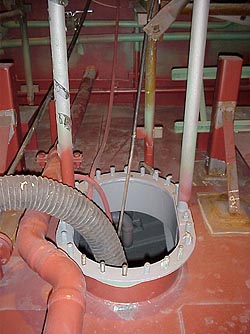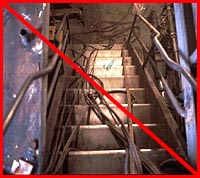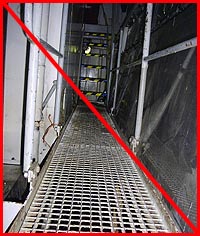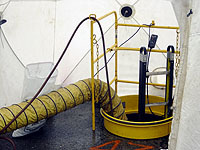Shipyard Employment eTool
Access and Guarding of Work Surfaces >> Access to Cargo Spaces and Confined Spaces

Typical access into cargo spaces is provided by the ship's ladders. A ship's ladders may be continuous straight ladders reaching up to 90 feet and may be without climbing devices, platforms, or protective cages. Confined spaces often have only one small means of entry. Portable ladders may be used to gain access to these spaces. [29 CFR 1915.72]

Potential Hazards
- Ship's ladders are often damaged or slippery.
- Ship's ladders are often blocked by cargo or materials.
- Cargo or materials are being moved while workers are using the ladder.
- Portables ladders may shift or slip.

Requirements and Example Solutions
- One safe and accessible ladder must be provided for each cargo space. [29 CFR 1915.76(a)(1)]
- Fixed ladders that are visibly unsafe must not be used. [29 CFR 1915.76(a)(2)]
- Portable ladders must be used when ship's ladders are visibly unsafe. [29 CFR 1915.76(a)(3) and 29 CFR 1915.72]
- Fixed ladders must have a 4-inch clearance behind the ladder rungs. [29 CFR 1915.76(a)(4)]
- Material or cargo must not be moved while workers are using access ladders. [29 CFR 1915.76(a)(5)]


Potential Hazards
- Limited egress from the space may be blocked.
- There may be only one means of egress from the space.

Requirements and Example Solutions
- More than one means of access must be provided to a confined space unless the structure of the vessel makes it impractical. [29 CFR 1915.76(b)(1)]
- When the ventilation ducts must pass through the means of access, ducts must allow for free passage. [29 CFR 1915.76(b)(2)] See Figure 2.
- Note: When there is only one means of access, collapsible ducts may be used to provide access.
- If ventilation equipment blocks access to the space, airline respirators as well as a stand-by employee must be used. [29 CFR 1915.51(c)(3)]
- Employees working alone in a confined space must be checked on at regular intervals [29 CFR 1915.84(a)]

